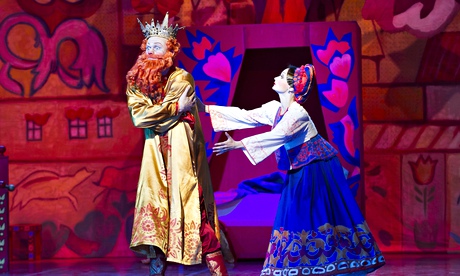
It seems extraordinary to modern audiences that Rimsky-Korsakov's last opera, The Golden Cockerel, so offended Nicholas II's censors that it was never performed in the composer's lifetime. But Rimsky, writing in the immediate aftermath of the 1905 revolution, knew what he was doing by breathing allegorical life into Pushkin's much-loved fairytale about a muddle-headed tsar whose attempt to evade the consequences of his youthful warmongering leads to his losing his heart to an oriental queen, his life to a magic rooster, and his kingdom to his people. The opera, but not the poem, ends with an epilogue by the Astrologer-cum-narrator consoling Tsar Dodon's bereft subjects with advice about the benefits of life without a Tsar.
No trace of politics is to be found, however, in this picture-book production by the Natalia Sats Moscow State Music theatre, on their third visit to the Coliseum with a Diaghilev mini-festival. For it was the great impresario who first brought the work to international attention, by staging the work as a ballet in the 1914 Ballets Russes season, with sets by Natalya Goncharova and choreography by Michel Fokine. Marking the work's centenary, the Natalia Sats company have sought faithfully to reproduce that production, Vyacheslav Okunev copying Goncharova's traditional "broadside" sets and costumes and Gali Abaidulov reworking what remains of Fokine's choreography. Crucially, too, the director, Georgy Isaakyan, has followed Diaghilev's idea to have the action staged almost entirely as a ballet, with chorus dressed as gnomes in white, gold-buttoned frocks with red hats and boots, and soloists, in evening dress, ranged at the sides.
The result is a charming and colourful show, appealing both to traditional opera audiences and to children with a taste for pantomime. The choreography is simple, constructed around two-dimensional comic mime figures, in keeping with the storybook style of the set and costumes. The only virtuosic dancing is left to Pavel Okunev's cockerel, who leaps and pirouettes round the stage, and to Natalia Savlieva's Queen of Shemakha, who luxuriates in the role's "oriental" sensuality. Particularly wonderful is the Queen's long encomium to her own beauty, her cascade of black hair and her breasts, "full and round yet light and airy as a daydream". Under conductor Alevtina Ioffe whose energetic and rather balletic direction keeps the orchestra tightly in check, the chorus and soloists are impressive. Especially good is Olesya Titenko's Queen, whose rich soprano blooms in Rimsky-Korsakov's winding chromatic lines, and Dmitry Pochapsky, whose colourful bass echoes dancer Oleg Fomin's buffoonery in the role of Dodon. Though neither very moving nor a laugh-a-minute, the brightly coloured pantomime and sparkling, energetic music make for a delightful evening.
• Until 10 July. Diaghilev festival continues to 13 July. Box office: 020-7845 9300. Venue: Coliseum, London.
• This article was amended on 11 July 2014 to clarify the origin of the ballet, and to correct the conductor to Alevtina Ioffe, rather than Oleg Beluntsov as our reviewer had it.

